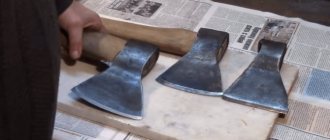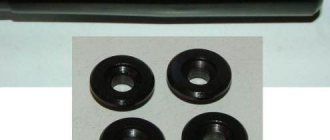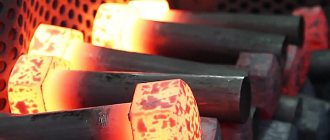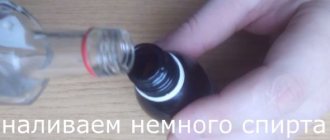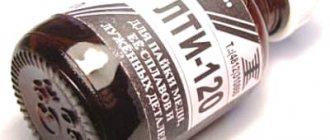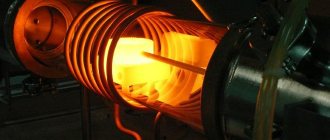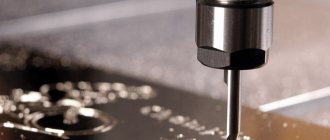- Hardening
- Heating the metal
- Product protection from scale and decarburization
- Coolants
- Vacation process
Heat treatment of steels is one of the most important operations in mechanical engineering, the correct implementation of which determines the quality of the products.
Quenching and tempering of steels are one of the various types of heat treatment of metals. Thermal effects on metal change its properties and structure. This makes it possible to increase the mechanical properties of the material, the durability and reliability of products, as well as reduce the size and weight of mechanisms and machines. In addition, thanks to heat treatment, cheaper alloys can be used for the manufacture of various parts.
It also won’t hurt you to know how to cook with a semi-automatic machine.
As the Steel Was Tempered
Heat treatment of steel involves applying heat to the metal under certain conditions to change its structure and properties.
Heat treatment operations include:
- annealing;
- normalization;
- aging;
- steel hardening and steel tempering (etc.).
Heat treatment of steel: hardening, tempering - depends on the following factors:
- heating temperatures;
- heating time (speed);
- duration of exposure at a given temperature;
- cooling rate.
Hardening
Steel hardening is a heat treatment process, the essence of which is to heat the steel to a temperature above the critical temperature, followed by rapid cooling. As a result of this operation, the hardness and strength of steel increase, and ductility decreases.
When steels are heated and cooled, the atomic lattice is rearranged. The critical temperature values for different grades of steel are not the same: they depend on the content of carbon and alloying impurities, as well as on the rate of heating and cooling.
After hardening, the steel becomes brittle and hard. When heated in thermal furnaces, the surface layer of products becomes covered with scale and is decarbonized the more, the higher the heating temperature and the holding time in the furnace. If the parts have a small allowance for further processing, then this defect is irreparable. Hardening modes for hardening steel depend on its composition and technical requirements for the product.
During hardening, parts should be cooled quickly so that austenite does not have time to transform into intermediate structures (sorbitol or troostite). The required cooling rate is ensured by selecting the cooling medium. In this case, excessively rapid cooling leads to cracks or warping of the product. To avoid this, in the temperature range from 300 to 200 degrees, the cooling rate must be slowed down, using combined hardening methods. The method of immersing the part in a cooling medium is of great importance to reduce warping of the product.
How to harden a variety of tool steel in unsuitable home conditions
Not all methods are suitable for amateurs. Many methods are applicable exclusively in factory complexes, because they have all the capabilities to carry out these processes.
We suggest you use our advice based on what material you will have in your work:
- To create a homemade cutting object, use stainless steel;
- Upon visual inspection, the surface should have a rich orange color;
- It is important to follow a certain cycle, where the raw material is immersed in hot water, then taken out into the air for about five minutes and again immersed back into the liquid;
- Plain steels have a dark cherry color, while medium alloy materials take on a red tint.
We warn that iron deteriorates if the heating rate is accelerated. Then you will get a color close to black or purple. It cannot be cleaned in any way. You will have to throw away the metal, since you will not be able to make the product you need. Steel that has acquired a brick color is considered optimal.
Equipment
To raise the temperature of the sample, any device for burning hydrocarbons (gas torch, blowtorch, cutter) is suitable. As a last resort, a fire is used, where coal is used to maintain the heat. Wood does not give off sufficient heat energy. Note that the listed methods are good for processing small parts.
If you are going to carry out hardening on an ongoing basis, you will have to build a muffle furnace on the ground.
You also need to think about cooling.
Ordinary water will do the job. When choosing a container, you need to take into account the parameters of the product so that it is immersed to the mark you need. For consumables or the manufacture of small items, containers are also needed. But when producing, for example, an ax or crowbar, a large bath will be required. The cooler is selected taking into account the cooling level:
- If you need to process a certain area, then just pour over the workpiece. The single technique is suitable for the manufacture of small products;
- The step-by-step process includes two steps. Initially, H2O is used, and then a boiling carbon composition (oil). This is a rather dangerous operation in which it is necessary to achieve quality without igniting the petroleum product.
Making a simple forge
Of course, you can buy equipment, but the price is quite high. Therefore, amateurs prefer to lay out the stove themselves.
For construction, you need a special brick, which contains fireclay clay, which can withstand heating temperatures of up to 2500 degrees. A distinctive feature of the material is a semicircle with a diameter of 5.5 cm extruded on the front part.
We begin construction:
- To prevent your future hearth from falling apart, you can use a special solution as fasteners. But it is better to weld the structure from a corner in the form of a frame. Place a cylinder in the center (preferably made of cast iron).
To ensure that the cone stands firmly, it is placed on welded support ribs and marks are made with a scriber.
Make cuts along the lines using an angle grinder.
Weld the ribs and cast iron cylinder in place using the spot method. Make sure that all elements are correctly positioned and perform final welding.
Turn the frame into working position and place the bricks as shown in the picture.
Install grate bars onto the resulting recess to supply air masses from below into the combustion zone. If incandescence is required at more than 1300 ⁰С, then you will have to install a fan for forced oxygen supply.
We weld a plug to discharge combustion products and the fan itself to the cone.
We assemble the entire structure and mount it on supports suitable for the height of the master. We do painting.
The vertical pipe must have a damper, which is used to clean the grate.
How to check vacation
Such heating does not require special equipment. For craftsmen, it is enough to keep the temperature from 200 to 250 ⁰C using a regular gas or electric oven. For this, 10–20 minutes will be sufficient, after which the workpiece is pulled out and allowed to cool. After low tempering, an increase in the hardness and density of the metal is observed.
Product protection from scale and decarburization
For products whose surfaces are not ground after heat treatment, carbon burnout and scale formation are unacceptable. Surfaces are protected from such defects by using protective gases supplied into the cavity of the electric furnace. Of course, this technique is only possible in special sealed ovens. The source of gas supplied to the heating zone is shielding gas generators. They can operate on methane, ammonia and other hydrocarbon gases.
If there is no protective atmosphere, then before heating the products are packaged in containers and covered with used carburizer and cast iron shavings (the heat engineer should know that charcoal does not protect tool steels from decarburization). To prevent air from getting into the container, it is coated with clay.
When heated, salt baths prevent the metal from oxidizing, but do not protect against decarbonization. Therefore, in production they are deoxidized at least twice per shift with brown salt, blood salt or boric acid. Salt baths operating at temperatures of 760 – 1000 degrees Celsius are very effectively deoxidized by charcoal. To do this, a glass with many holes over the entire surface is filled with dried charcoal, closed with a lid (so that the coal does not float up) and, after heating, lowered to the bottom of the salt bath. First, a significant number of flames appear, then it decreases. If you deoxidize the bath three times during a shift in this way, the heated products will be completely protected from decarbonization.
The degree of deoxidation of salt baths is checked very simply: an ordinary blade, heated in a bath for 5 - 7 minutes in a high-quality deoxidized bath and hardened in water, will break, not bend.
Coolants
The main coolant for steel is water. If you add a small amount of salts or soap to the water, the cooling rate will change. Therefore, under no circumstances should the quenching tank be used for other purposes (for example, washing hands). To achieve the same hardness on the hardened surface, it is necessary to maintain the coolant temperature at 20 - 30 degrees. You should not change the water in the tank frequently. It is absolutely unacceptable to cool the product in running water.
The disadvantage of water hardening is the formation of cracks and warping. Therefore, only products of simple shapes or cemented ones are hardened using this method.
- When hardening products of complex configurations made of structural steel, a fifty percent solution of caustic soda is used (cold or heated to 50 - 60 degrees). Parts heated in a salt bath and hardened in this solution turn out light. The solution temperature should not be allowed to exceed 60 degrees.
Modes
The vapors generated during quenching in a caustic solution are harmful to humans, so the quenching bath must be equipped with exhaust ventilation.
- Alloy steel is hardened in mineral oils. By the way, thin carbon steel products are also carried out in oil. The main advantage of oil baths is that the cooling rate does not depend on the oil temperature: at a temperature of 20 degrees and 150 degrees, the product will cool at the same rate.
Be careful not to let water get into the oil bath, as this may cause the product to crack. What is interesting: in oil heated to a temperature above 100 degrees, the ingress of water does not lead to the appearance of cracks in the metal.
The disadvantage of an oil bath is:
- release of harmful gases during hardening;
- formation of plaque on the product;
- oil's tendency to flammability;
- gradual deterioration of hardening ability.
- Steels with stable austenite (for example, X12M) can be cooled with air supplied by a compressor or fan. At the same time, it is important to prevent water from entering the air duct: this can lead to the formation of cracks in the product.
- Step hardening is performed in hot oil, molten alkalis, and low-melting salts.
- Intermittent hardening of steels in two cooling environments is used for processing complex parts made of carbon steels. First they are cooled in water to a temperature of 250 - 200 degrees, and then in oil. The product is kept in water for no more than 1 - 2 seconds for every 5 - 6 mm of thickness. If the exposure time in water is increased, cracks will inevitably appear on the product. Transferring the part from water to oil must be done very quickly.
Welding a car with your own hands is not an easy task, but it can be done.
Do you need to cut metal quickly and efficiently? Use a plasma cutter! How to do it correctly, read this article.
If you are interested in how to turn metal products, read the article at https://elsvarkin.ru/obrabotka-metalla/tokarnaya-obrabotka-metalla-obshhie-svedeniya/ link.
Vacation process
All hardened parts are subject to tempering. This is done to relieve internal stress. As a result of tempering, the hardness of the steel is slightly reduced and the ductility of the steel is increased.
Depending on the required temperature, tempering is carried out:
- in oil baths;
- in saltpeter baths;
- in furnaces with forced air circulation;
- in baths with molten alkali.
The tempering temperature depends on the grade of steel and the required hardness of the product, for example, a tool that requires a hardness of HRC 59 - 60 should be tempered at a temperature of 150 - 200 degrees. In this case, internal stresses decrease and hardness decreases slightly.
High-speed steel is tempered at a temperature of 540 - 580 degrees. This tempering is called secondary hardening, since as a result the hardness of the product increases.
Products can be tarnished by heating them on electric stoves, in ovens, even in hot sand. The oxide film that appears as a result of heating acquires different tarnish colors, depending on the temperature. Before you start tempering one of the tarnish colors, you need to clean the surface of the product from scale, oil deposits, etc.
Usually, after tempering, the metal is cooled in air. But chromium-nickel steels should be cooled in water or oil, since slow cooling of these grades leads to temper brittleness.
Salt electrode bath
| This article lacks links to sources of information. Information must be verifiable, otherwise it may be questioned and deleted. You may edit this article to include links to authoritative sources. This mark was set on February 21, 2022. |
Ignition of a salt electrode bath in industrial conditions (temperature 1100 C°)
A salt electrode bath is a metal or ceramic bath filled with salt into which electric heaters are immersed. The part of the bath in which the electric heaters are located is separated from the working part by a partition. The bathtub is placed in a housing and covered with an umbrella on top. To start the bath, a special immersion electric heater is used. Salt baths provide quick and uniform heating of products placed in molten salt. They are used, in particular, for heating for hardening and tempering of tools.
Advantages:
— faster (4-5 times) heating compared to electric and gas heating furnaces;
— uniform heating of the entire surface of the part;
— uniformity of the temperature field throughout the melt with an error of ±1 °C;
— the possibility of partial heating for hardening (for example, only the working part of the drill or the striking part of the chisel);
— when heated, parts do not oxidize;
— high operating temperatures:
HEAT TREATMENT IN SALT, BARIUM AND ALKALINE BATHS
Parts of steel machines and tools of various groups are exposed to thermal effects for the purpose of treatment in salt, barium and alkaline baths. Processing products in this way contributes to a qualitative improvement in the mechanical characteristics of the surface.
Melts of technical salts, their mixtures, alkalis and acids have proven themselves well in the processing of parts for hardening, tempering, isothermal hardening of products, and normalization.
Temperature treatment takes place in salt baths at different heating levels (low, medium, high), where the temperature ranges from 140C to 1300C. By processing workpieces using this method, it is possible to eliminate the appearance of fractures, cold hardening, and other types of deformations. In addition, stress is relieved after rough processing, the original structure is leveled, and the strength limit of parts working in tension, compression or bending increases.
General information about bathtub stoves.
Bath furnaces are used for heating for hardening, tempering, normalization, chemical-thermal treatment and for cooling during stepwise and isothermal hardening.
Depending on the heat treatment process, molten salts, alkalis, metals (lead, tin, alloys of lead and tin, alloys of lead and silumin, etc.) and mineral oils are used as liquid media.
Molten salts contain dissolved oxygen and oxides, which cause oxidation and decarburization of steel. Therefore, before work and during work, the bath is periodically deoxidized with special mixtures. To deoxidize baths with chloride salts, small additions of ferrosilicon or borax are used, and for barium chloride - magnesium fluoride. To deoxidize alkaline baths - cyanide salts.
The advantages of bath furnaces: high speed and uniformity of heating of parts, accuracy of temperature control, absence of oxidation and decarbonization, the possibility of local thermal and chemical-thermal treatment. Disadvantages of bath furnaces: the need to periodically change salts, low durability of crucibles, the possibility of corrosion of the surface of a part if it is not cleaned of salts in a timely manner, and the requirement for very strict adherence to labor safety rules. With proper organization of bathtub operation, most of the shortcomings can be easily eliminated, which is why they are widely used in heat treatment.
The baths can operate on any type of fuel and electricity. According to the heating method, bath furnaces are distinguished with external heating, with internal heating, and electrode ones.
Baths with external heating.
Baths with external heating. They are a crucible inserted into a furnace with electric or flame heating. Crucibles can be cast, stamped or welded with a wall thickness of 12-30 mm. Heat is transferred to the melt through the walls of the crucible, so the temperature of the furnace working space must exceed the temperature of the melt, which increases the risk of burning out the crucible. In the event of a burnout of the crucible, a drain for salts and liquid metal is provided in the bath.
The average productivity of flame-heated baths, depending on the size of the crucible, ranges from 20 to 125 kg/h.
Rice. 1. Electric crucible furnace-bath type SVG: / - crucible, 2 - working chamber, 3 - cast iron plate, 4 - sliding lid, 5 - exhaust hood, 6 - thermocouple, 7 - hole for hanging fixtures with parts
Electric bath furnaces are widely used in thermal production. External heating of the crucible is carried out by heaters made of high electrical resistance alloys. The operating temperature of the bath does not exceed 850° C.
Disadvantage of baths with external heating: difficulty in obtaining high temperatures and relatively low efficiency
Crucible electric bath furnaces with external heating are available in three types: SVG-1.5.2/8.5, SVG-2.5.3.5/8.5 and SVG-3.5.4/8.5 with a capacity of 30, 60 and 100 kg /h and power 10, 20 and 30 kW.
An electric furnace-bath of the SVR type is shown in Fig. 1. Temperature control is carried out by thermocouples. One thermocouple is brought out through the lid and controls the temperature in the crucible, the other thermocouple is placed in the working space of the bath near the heaters. This thermocouple is connected to automatic temperature control devices.
The bath below the crucible has a drain for molten salts in case the crucible burns out.
Baths with internal heating.
Baths with internal heating. They have tubular heaters lowered directly into the melt. Internal heating reduces heat loss, increases the efficiency of the furnace, increases the service life of the crucible and helps to obtain a uniform temperature in it. To speed up heating and increase its uniformity, the baths have mechanical electric stirrers or pumps.
A bath with tubular heaters (TEH) for heat treatment of parts made of aluminum alloys is shown in Fig. 2. Maximum operating temperature of the bath is 520° C, power is 300 kW.
Rice. 2. Diagram of an electric bath with internal heating:
/ - welded crucible, 2 - lining cover, 3 - U-shaped heating elements
Electrode furnaces-baths.
In these baths, the heater is the salt itself, reminiscent of a bath.
Current is supplied to the electrodes using busbars from a special transformer, which reduces the voltage from 220/380 V to 24.2-5.5 V. The current is passed between the steel electrodes. To avoid electrolysis of the salt, alternating current is used.
Molten salts have high electrical resistance and when current passes through them, heat is released, sufficient to heat the salt and maintain the required temperature of the melt. In solid form, salt does not conduct electricity.
These ovens are the most economical. Three-phase electrode furnaces of the SHS type have become widespread in industry.
Salt electrode baths are used: up to 650 ° C - low-temperature tempering of steel, annealing and heating for hardening of aluminum alloys, tempering, low-temperature cyanidation, nitriding and the first stage of heating for hardening of high-speed steel;
up to 850° C - for heating for hardening of carbon steel, medium-temperature cyanidation, annealing of steel and non-ferrous metals, for the second stage of heating for hardening of high-speed steel;
up to 1000° C - for heating carbon and low-alloy steel for hardening and for heat treatment of cast iron castings;
up to 1300°C - for heating for hardening of high-speed steel, annealing of stainless steels, etc.
Electrode baths are produced with a power of 35, 60 and 100 kW.
Rice. 3. Design of the electrode bath SVS-35/13: 1_ casing, 2 — lining. 3 - partition, 4 - chain curtain (to protect workers from splashes of molten salt), o - exhaust hood, 6 - pyrometer. 7 — electrodes (3 pcs.). 8 - counterweight
The baths have a rectangular workspace with dimensions up to 350X800X400 mm. These baths have internal screens that separate the electrodes from the working volume of salt. With this design, current does not pass through the parts, the screen protects them from contact with the electrodes, and allows better use of the working volume of salt. A metal partition protects the electrode group from a possible short circuit through a heated part.|
Bath temperatures up to 1300°C are measured with a radiation pyrometer, and for temperatures up to 1000°C - with thermocouples.
The salt baths are started using a device (a stand with nichrome heaters). When current is passed from the transferator, the device heats up and melts the salt. The device is in hardened salt. The three-phase electrode furnace-bath SBC-35/13 (power 35 kW, maximum operating temperature 1300°C) is shown in Fig. 3.
For heat treatment of high-speed steel, three- or four-electrode crucible furnaces-baths are used. Bathtubs are mounted in one frame and masonry. Each crucible is designed for a separate operation: the first for heating to approximately 650 ° C, the second to 850 ° C, the third for final heating to 1260-1280 ° C, and the fourth for cooling for stepwise hardening.
Oil bath stoves.
Used for low tempering, artificial aging and cooling during stepwise and isothermal hardening. An electric oil bath with insulated heaters is shown in Figure 4. These bath furnaces have the CBM index. The numbers in the numerator of the index indicate the length of the working space (diameter) and height (dm), the denominator indicates the temperature in hundreds of degrees. The baths are produced with crucible sizes: width 5.8 and 10 dm, length 5X8 and 10 dm and height 5 and 10 dm. Power from 15 to 40 kW. Round oil baths (Fig. 5) are manufactured with a steel crucible with a diameter of 2.5; 3.5; 5.0; 8.0 dm and height 2.5; 5.0; 8.0; 10.0 dm.
Power 5-20 kW. In large baths with a depth of more than 10 dm, stirrers are provided for mechanical mixing of the oil.
Thermal production based on salt bath furnaces
Salt baths have a high heating rate and, as a result, productivity. They easily and effectively process any type of cutting tool, products made from high-speed and die steels, individual sections of end products, etc. In addition, during heating and cooling, products located in a molten salt environment are protected from oxidation.
Advantages of heat treatment in molten salts and alkali
The technology of temperature and chemical-thermal treatment in baths of molten salts and alkalis is very widespread due to the fact that in many respects it is significantly superior to other types of heating. For example, this processing method reduces deformation, protects against the formation of oxides and allows local action.
During the increased rate of uniform heating by 4-5 times due to the high heat transfer coefficient, as well as the mobility of salt and alkaline melts, a significant slowdown in grain growth occurs during heat treatment, increases ductility and reduces the possibility of cracking and breaking of the metal during subsequent cold machining.
Molten salts minimize the formation of scale and warping, promote carbon reduction (decarburization), and high-precision temperature control helps prevent defects caused by local overheating or underheating of the product. Under conditions of using inert salts, the occurrence of stains and residual deposits on the surface of parts and workpieces is excluded.
Molten salts and alkalis have a good cooling effect, which provides metal products made from carbon, high-speed and low-alloy steels with the required hardness, eliminating the formation of cracks and the so-called “steam jacket”.
Only dry products are processed in a salt bath oven, the surface of which is well cleaned from gasoline, dirt, oils, aluminum dust, and has no traces of rust or paint, as well as any other organic substances. The composition of the environment for chemical-temperature and temperature treatment of metal parts is set individually. In each specific case, the composition can be formed on the basis of fluorides, chlorides, carbonates and other types of salts that have a high melting point, low volatility, and are resistant to decomposition when heated. To prevent processed parts from decarburizing, hydroxides and other materials are used in the process.
After a steel part is immersed in a molten salt environment, a strong crust immediately forms on its surface. As this crust dissolves, the process of heat transfer from the melt proceeds faster. The hardness and thickness of the crystal formation depends on the size and temperature of the part; the higher the temperature and heat capacity of the melt, the sooner the salt shell “disappears.”
In order to achieve a homogeneous microstructure and the required quality characteristics of the metal, a specialist monitors the temperature regime in the salt bath and, depending on the chemical composition of the heated product, the density of the salt medium, the depth and method of immersion of the part, its shape and other indicators, calculates the duration of the heating cycle .
In the workshops of the Ionmet metal service enterprise, furnaces with salt electrode baths are installed, intended for heat treatment of large-sized products. The length, width and depth of the baths are 500 mm, 350 mm and 450 mm respectively.
SMC "Ionmet" processes parts for any purpose in molten salts and alkalis, as well as tool blanks, semi-finishing parts and other products for heat treatment.
The high efficiency of temperature treatment in furnaces with salt baths allows the use of this technology for normalization, high tempering, annealing of hardened tools, finished parts and workpieces, preliminary and final heating for hardening of parts and tools made of high-speed and other high-alloy steels, cooling in molten chloride salts for step hardening of products and tools, etc.
Processing workpieces in salt and alkaline melts makes it possible to achieve cross-sectional hardness and homogeneity of structure, improve the subsequent workability of workpieces, reduce hardness, prevent naphthalene fracture during secondary hardening, correct the microstructure of products and solve many other problems.
Calculation of time and temperature conditions, selection of salt and alkaline composition, rectifiers in order to prevent carbon burnout, is carried out individually and depends on the goals that need to be achieved by this processing method, as well as on the conditional thickness of the parts. An effective method of protection against decarburization requires constant monitoring of the concentration of the molten salt during heating and the formation of oxides in the salt bath.
Source
